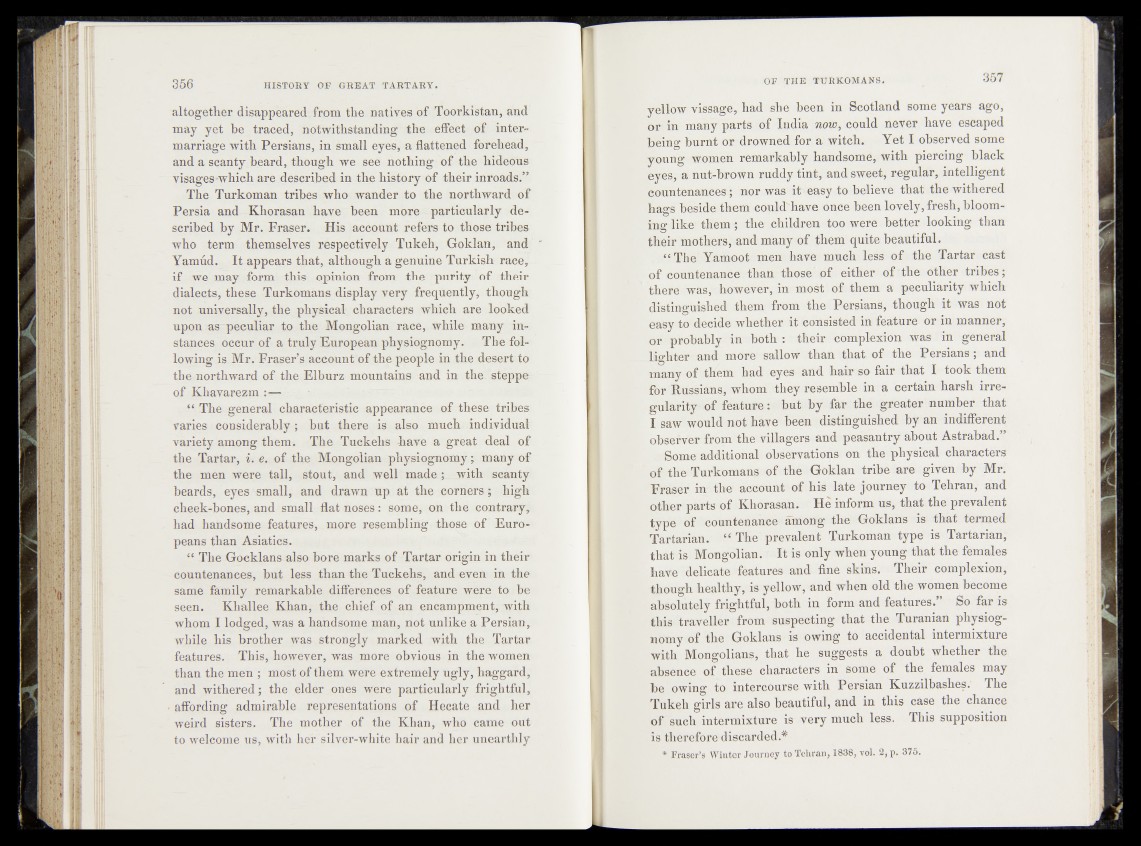
altogether disappeared, from the natives of Toorkistan, and
may yet he traced, notwithstanding the effect of intermarriage
with Persians, in small eyes, a flattened forehead,
and a seanty beard, though we see nothing of the hideous
visages*which are described in the history of their inroads.”
The Turkoman tribes who wander to the northward of
Persia and Khorasan have been more particularly described
by Mr. Fraser. His account refers to those tribes
who term themselves respectively Tukeh, Goklan, and
Yamud. It appears that, although a genuine Turkish race,
if we may form this opinion from the purity of their
dialects, these Turkomans display very frequently, though
not universally, the physical- characters which are looked
upon as~peculiar to the Mongolian race, while many instances
occur of a truly European physiognomy. The following
is Mr. Fraser’s account of the people in the desert to
the northward of the Elburz mountains and in the/steppe
of Khavarezm
“ The general characteristic appearance of these tribes
varies considerably ; but therex is also much- individual
variety among them. The Tuckehs have a great deal of
the Tartar, i. e._ of the Mongolian physiognomy ; many of
the men were tall, stout, and well made ; with scanty
beards, eyes small, and drawn up at the corners $ high
cheek-bones, and small flat noses: some, on the contrary,
had handsome features, more resembling those of* Euro*
peans than Asiatics. ,,
“ The Gocklans also bore marks of Tartar origin in their
countenances, but less than the Tuckehs, and even in the
same family remarkable differences pf feature were to be
seen. Khallee Khan, the chief of an encampment, with
whom I lodged, was a handsome man, not unlike a Persian,
while his brother was strongly marked with the Tartar
features. This, however, was more obvious in the women
than the men ; most of them were extremely ugly, haggard,
and withered; the elder ones were particularly frightful,
affording admirable representations of Hecate and her
weird sisters. The mother of the Khan, who came out
to welcome us, with her silver-white hair and her unearthly
yellow vissage, had she been in Scotland some years ago,
or in many parts -of India now, could never have escaped
being burnt or drowned for a witch. Yet I observed some
young women remarkably handsome, with piercing black
eyes, a nut-brown ruddy tint, and sweet, regular, intelligent
countenances ; nor was ifceasy to believe that the withered
hags beside them could:have once been lovely, fresh, blooming
like* them; the children too were better looking than
their mothers, and many of them quite beautiful.
.-;“ fFhe' Yamoot men have much less of the Tartar cast
of countenance than those"pf either of the other tribes;
there was, however, in most of them a peculiarity which
distinguished them from the Persians, though it was not
easy to decide whether it Consisted in feature or in manner,
or probably in both : their complexion was in general
.-lighter and more-4 sallow than that.'of the Persians; and
many of them had eyes and hair so fair that I took them
for Russians, whom they resemble in a certain harsh irregularity
®f feature: but by far the greater number that
I saw would not have been distinguished by an indifferent
observer from the villagers and' peasantry about Astrabad.
fifiome additional observations on the physical characters
' of the Turkomans of the Goklan tribe are given by Mr.
Fraser in the account of his late journey to Tehran, and
other‘parts of Khorasan. He inform us, that the prevalent
type of countenance among the Goklatfs is that termed
Tartarian. “ The' prevalent Turkoman type is Tartarian,
that is Mongolian.r It is only when young that the females
have delicate features and fine skins. Their complexion,
though healthy, is yellow, and when old the women become
absolutely frightful, both in form and features.’’ So far is
this traveller from suspecting that the Turanian physiognomy
of the Goklans is owing to accidental intermixture
with Mongolians, that he suggests a doubt whether the
absence of these characters in some of the females may
he'owing to intercourse with Persian Kuzzilbashes: The
Tukeh girls are also beautiful, and in this case the chance
of such intermixture is very much less. This supposition
is therefofe-discarded.#
♦ Fraser’s Winter Journey to Tehran, 1838, vol. 2, p. 375.